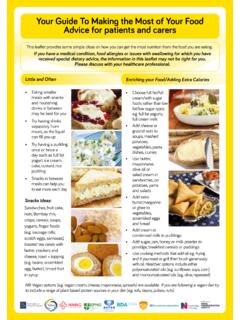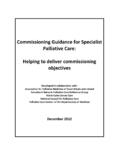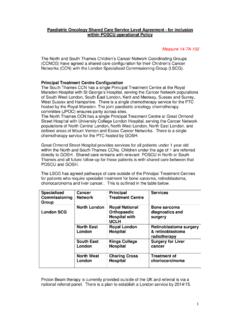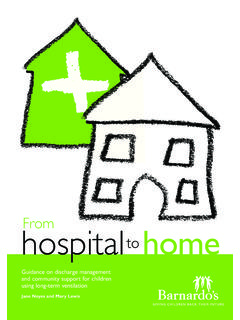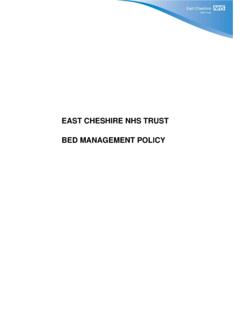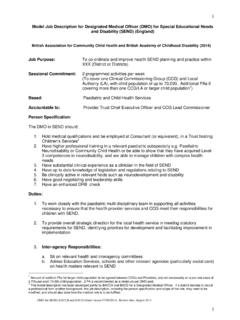Transcription of www.malnutritionpathway.co.uk
1 Including a pathway for the appropriate use of Oral Nutritional Supplements (ONS) by a multi-professional consensus panel2nd Edition: 20171st Edition produced May 2012(Document to be reviewed November 2020)A Guide to Managing Adult Malnutrition in the CommunityContentsIntroduction 3 Malnutrition Overview4- Size of the Problem 4- Clinical Consequences 4- Cost Implications 4- Groups at Risk4 Identification of Malnutrition Nutrition Screening 5 Management of Malnutrition5- Goal Setting 5- Monitoring the Intervention 5 Optimising Nutritional Intake6- NICE Guidance 6- Dietary Advice 6- Oral Nutritional Supplements (ONS) 6-7- Commencing ONS 7- Prescribable Indications 7- Discontinuing ONS 7 Managing Malnutrition According to Risk Category 8 Pathway for using Oral Nutritional Supplements in the Management of Malnutrition 9 Useful Resources and Websites10 References 11 Pull-out Pathway Posters12-13 ConsensusPanelAnne Holdoway(Panel Chair) Consultant Dietitian, Specialist in Gastroenterology and Palliative Care Liz AndersonNutrition Nurse Specialist, Bucks Healthcare NHS Trust, Chair of the NationalNurses Nutrition Group (NNNG)
2 Iain McGregorClinical Director Healthcare Education and Registered NurseLouise NashDietitian, Frail Elderly Pathway Team, Airedale NHS Foundation Trust Dr Anita NathanGeneral Practitioner, Member of the GPs Interested in Nutrition Group Ruth NewtonNutrition Pharmacist, Countess of Chester Hospital, Chair of the BritishPharmaceutical Nutrition GroupBarbara ParsonsCommunity Pharmacist and previous Head of Pharmacy Practice at thePharmaceutical Services Negotiating Committee (PSNC) The document has also been reviewed by Dr Graham Duce, Clinical CommissioningGroup GP Clinical and Prescribing Lead, Cheshire02| Managing Adult Malnutrition in the CommunityNB: Previous panel members on the 2012 edition of the document included some ofthe current consensus panel as well as Dr Ailsa Brotherton; Senior Research Fellow,Pamela Mason; Community Pharmacy and Nutrition Consultant and Dr Rachel Pryke;Royal College of General Practitioners Clinical Champion for Nutrition for panel members declare that theyhave no conflicts of interest inrelation to this document.
3 Costs oftime, travel and accommodation forattending meetings and printing thisdocument were met by anunrestricted educational grant fromNutricia Advanced Medical Nutrition( ). The contentand key messaging has beendeveloped and agreed by the expertconsensus panel. Library serviceswere provided by Nutricia MedicalAffairs department upon document is a practical guide to support healthcare professionals in the community to identify andmanageindividuals at risk of malnutrition and particularly disease-related malnutrition, including theappropriate use of oral nutritional supplements (ONS).This document has been written and agreed by a multi-professional consensus panel with expertise and aninterest in malnutrition, representing their respective professional associations.
4 Members of the public wereinvolved in developing the patient/carer resources. The aim of this document is to: - Assist healthcare professionals to optimise patient outcomes through good nutritional care - Raise awareness of key patient groups who are at particular risk of malnutrition and should benefit fromintervention- Address inappropriate prescribing whilst at the same time ensuring we are identifying those most at risk ofmalnutrition- Reduce the financial impact of malnutrition on health and social care - malnutrition is estimated to cost morethan 19 billion each year in England alone1which equates to over 90 million per average sized CCG1,2 Topics covered: Disease-related malnutrition How to undertake nutritional screening to identify malnutrition Management according to the degree of malnutrition risk Evidence-based management pathway for using oral nutritional supplements appropriatelyTopics not covered: Parenteral nutrition Enteral tube feeding Acute hospital setting Paediatrics (patients under 18 years of age) Eating disordersThis document is based on clinical evidence, clinical experience and accepted best practice.
5 Local guidancemay be available; contact your dietetic department for information or refer to your local formulary. Disease specific guidance is also available: COPD - Managing Malnutrition in COPD ( ) Lung Cancer A Practical Guide for Lung Cancer Nutritional Care ( ) For more detailed support on complex conditions it is suggested advice is sought from a registered Adult Malnutrition in the Community | 03 This booklet supports the implementation of recommendations in the NICE guideline on nutrition support foradults ( ). It also supports statements 1, 2 and 5 in the NICE quality standard fornutrition support in adults ( ).National Institute for Health and Care Excellence. December 2017 NICE Endorsement Statement - Managing Adult Malnutrition in the Community04| Managing Adult Malnutrition in the CommunityMalnutrition costs in excess of 19 billion per annum in England alone, based on malnutrition prevalence figures andthe associated costs of both health and social care1 (based on 2012 data).
6 This breaks down to a cost of over 90 million per CCG based on 207 CCGs in England1,2 It is estimated that the cost of healthcare for a malnourished patient is 5763 (based on the point prevalence ofmalnutrition and annual expenditure on malnutrition) and 1645 for social care compared to that for non-malnourishedpatients of 1715 and 440, respectively1 Malnutrition OverviewChronic disease4,5(consider acute episodes): chronic obstructive pulmonary disease (COPD), cancer, gastrointestinaldisease, renal or liver disease and inflammatory conditions such as rheumatoid arthritis, inflammatory bowel diseaseProgressive neurological disease5:dementia, Parkinson s disease, motor neurone disease (MND)Acute illness5:where adequate food is not being consumed for more than 5 days (more commonly seen in a hospitalthan a community setting)Debility4:frailty, immobility, old age, depression, recent discharge from hospitalSocial issues5:poor support, housebound, difficulty obtaining or preparing foodRehabilitation: after stroke5, injury4, cancer treatment4 End of Life/Palliative Care18,19:tailor and adjust advice according to phase of illness More hospital admissions/readmissionsLonger length of stay in hospital Greater healthcare needsin the community(more GP visits,care at home, antibiotics)While malnutrition can refer to either over or undernutritionthis document refers specifically to undernutrition.
7 A deficiency of energy, protein and other nutrients that causes adverse effects on the body (shape, size and composition),the way it functions and clinical outcomes3. Most malnutrition is disease-related, although some social and mechanical( dentition) factors can also have an malnutrition can improve nutritional status and clinical outcomes and reduce health care use andassociated costs1. The National Institute of Health and Care Excellence has shown substantial cost savings can result from identifying and treatingmalnutrition: implementation of the Clinical Guideline 32: Nutrition Support for Adults14and supporting Quality Standard2415have been shown to be high impact with respect to cost savings16 The cost of managing malnutrition using prescribable nutrition support (including oral nutritional supplements, tubefeeds and parenteral nutrition) is low at < of the total expenditure on malnutrition17 Groups at risk of malnutrition include those with.
8 Size of the problem At any point in time more than 3 million people in theUK are malnourished or at risk of malnutrition, most(~93%) live in the community5 Malnutrition (undernutrition) affects: 35% of people recently admitted to care homes6 29% of adults on admission to hospital7 30% attending hospital outpatients8 11% of people at GP practices9 Cost implications of malnutritionThe healthcare cost of managing individuals with malnutrition is three to four times greater than that of managing non-malnourished individuals, due to higher use of healthcare people have1:Clinical consequences of malnutrition Increased falls risk12,13 Impaired recovery from illness and surgery4 Poorer clinical outcomes higher mortality4 Impaired immune response4 Reduced muscle strength4and frailty10,11 Impaired wound healing4 Impaired psycho-social function4 Managing Adult Malnutrition in the Community | 05 Identification of Malnutrition - Nutrition ScreeningManagement of MalnutritionGoal Setting Agree goals of intervention with individual/carer Set goals to assess the effectiveness of intervention (see examples in box) Consider disease stage and treatment, adjusting goals of interventionaccordingly.
9 For example nutritional interventions in some groups, suchas palliative care and patients undergoing cancer treatment, may notresult in improvements in nutritional status, but may provide a valuablesupport to slow decline in weight and function Discuss intervention with patient/carer to ensure that it is feasible forthem to implement/tolerate Monitoring the intervention Monitor progress against goals and modify intervention appropriately Consider weight, strength, physical appearance, appetite, ability toperform activities of daily living compared with the goals originally set Frequency of monitoring depends on setting, treatment, anticipation ofpatients likely projection and organisational policy (see pages 8 and 9)Malnutrition can be identified using a validated screening tool such as the Malnutrition Universal Screening Tool ( MUST )3 - see NB: Healthcare professionals using screening tools should have appropriate skillsand to screenOpportunistically On first contact within a new care upon registration with GP, first home visit, firstoutpatients appointment, on admission to a hospital orresidential care setting14,15.
10 Other opportunities for screeninginclude contact with district nurse or communitypharmacist, for example at medication usage review (MUR).Upon clinical concern - examples include: unplannedweight loss, appearing thin, fragile skin, poor woundhealing, pressure ulcers, apathy, muscle wasting, poorappetite, altered taste sensation, difficulty swallowing,altered bowel habit, loose fitting clothes or prolongedintercurrent consider groups at risk of malnutrition (see page 4).Recommended screening frequency Once an individual has been highlighted at risk ofmalnutrition, regular screening and monitoring isrecommended to determine any improvement ordeterioration and action required14 Frequency is determined by risk category as per MUST score (see page 8) In most cases malnutrition is a treatable condition that can be managed using first line dietary advice to optimise foodintake and oral nutritional supplements (ONS) where necessary20 Management of malnutrition should be linked to the level of malnutrition risk (see page 8) People who are malnourished or at risk of malnutrition should have a care plan For all individuals: record risk correct/manage underlying causes advise agree goals of int


